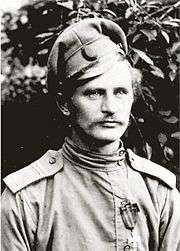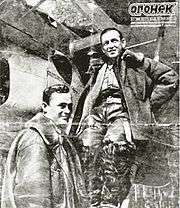Endel Puusepp
| Endel Puusepp | |
|---|---|
 Major Endel Puusepp in 1942. | |
| Born |
1 May 1909 Samovolny farm, Yeniseysk Governorate, Russian Empire |
| Died |
18 January 1996 (aged 86) Tallinn, Estonia |
| Allegiance | Soviet Union |
| Service/branch | Soviet Air Force |
| Rank | Colonel |
| Awards |
Hero of the Soviet Union Order of Lenin Order of the Red Banner Order of the Red Star (2) Order of the Patriotic War, 1st Class (2) Order of Suvorov, 3rd class Order of Alexander Nevsky Order of the Red Banner of Labour (3) Order of Friendship of Peoples Order of the Badge of Honor |
Endel Puusepp or Pusep (Russian: Эндель Карлович Пусэп; May 1, 1909 – June 18, 1996) was a Soviet Estonian World War II pilot, who completed over 30 night-time long-range bombing missions against Nazi Germany. He was a recipient of the Hero of the Soviet Union award for flying a high-ranking delegation over the front line from Moscow to Washington, D.C. and back to negotiate the opening of the Western Front.[1][2]
Early life

Endel Puusepp was born into a family of Estonian peasants living in Yeniseysk Governorate, Siberia. His parents moved there, drawn by an offer of the Russian government to be given as much land as they could manage to cultivate. Thus, thousands of Estonians settled in Siberia and built farms, where they preserved their language and culture.[1] Ever since early childhood, Puusepp dreamed of becoming a pilot. His parents, however, envisaged a different career for him: either a teacher or an agronomist. Having completed 7 grades of school, Puusepp moved to Leningrad to study at the Estonian-Finnish Teachers' College.
Aviation career
After completing one year of studies at the teacher's college, Puusepp transferred to a pilot's school, first in Volsk and later in Orenburg. He stayed at the latter as a flight instructor, having graduated. He was later transferred to a newly formed squadron specializing in blind flying (using only the airplane's instruments due to limited visibility).
Polar aviation
By 1938, Puusepp was an established pilot, proficient in blind flying. Even earlier, he participated in the operation to locate the plane of Sigizmund Levanevsky, which disappeared in the Arctic.[3] The North captivated Puusepp so much that he decided to stay and work there. He flew to the ice station North Pole-1 on several occasions and visited other Soviet Arctic stations. He was also involved in creating optimal routes for ships and in observing the movements of ice. While on one of these missions over the Kara Sea, Puusepp learned about the onset of the Operation Barbarossa. Having landed, Puusepp requested a transfer to the front line.
World War II

On August 8, 1941, under the command of Mikhail Vodopianov, Puusepp participated in his first bombing mission. After successfully dropping bombs on Berlin and while returning to the home base, his airplane was heavily damaged by anti-aircraft artillery, resulting in an emergency landing in Estonia, then occupied by the Nazis. Upon exiting the plane, the crew encountered a frightened shepherd boy. Puusepp, who did not forget his native Estonian was able to find out the location of the Nazi troops from him and avoid being captured, safely returning to Soviet-controlled territory.[4] By April 1942, Puusepp completed 30 nighttime long-range bombing missions against Berlin, Danzig, and Königsberg.

By that time, the Soviet Union was involved in negotiations with the Allies concerning the opening of the Western front. It was decided to send a Soviet delegation headed by the Foreign Minister Vyacheslav Molotov, first to Great Britain and then to the United States. Puusepp was chosen to be the pilot for this unprecedented and highly risky operation, involving flying over the front line and enemy-controlled territories. On May 29, 1942, after stopping in Tealing, Prestwick, Reykjavík, and Goose Bay, the Petlyakov Pe-8 plane with the Soviet delegation on board landed in Washington.[2] Returning home was even more perilous. Puusepp feared the Nazis were aware of the completed negotiations, and would intend to intercept the delegation on its way back. A ruse was employed involving reports published by the Soviet press, announcing the successful return of the Soviet delegation.[2] It was only after this act of disinformation that the airplane set course for Moscow. For successful completion of the mission, Puusepp was given the Hero of the Soviet Union award. Upon receiving it, he remarked, surprised, that he didn't do anything extraordinary.
He continued bombing missions against the enemy troops in Stalingrad, Kursk, Oryol, and Belgorod. During one of the missions, Puusepp sustained a shrapnel injury of his spine and had to undergo 5 surgeries. He never fully recovered and retired from the Soviet Air Force in 1946 at the rank of colonel.[3]
Later years
After the war, Puusepp moved to Tallinn, where he was appointed head of the Central Board of Road Transport of the Estonian SSR. In 1950, he was elected Vice Chairman of the Supreme Soviet of the Estonian SSR and later worked as Minister of Social Insurance of the republic.[5]
Endel Puusepp died on June 18, 1996. He is buried at the Metsakalmistu cemetery in Tallinn.[3]
References
- 1 2 Мы помним тебя, Эндель Пусэп! (in Russian). Krasnaya Zvezda. 2007-11-28. Retrieved 2008-03-06.
- 1 2 3 Эндель Пусэп – эстонский брат Бронзового солдата (in Russian). Izvestiya. 2007-12-13. Retrieved 2008-03-09.
- 1 2 3 Герой Советского Союза Пусэп Эндель Карлович (in Russian). warheroes.ru. Retrieved 2008-03-09.
- ↑ У второго фронта был эстонский акцент (in Russian). Komsomolskaya Pravda. 2007-05-31. Retrieved 2008-03-09.
- ↑ Эндель Карлович Пусэп (in Russian). peoples.ru. Retrieved 2008-03-10.